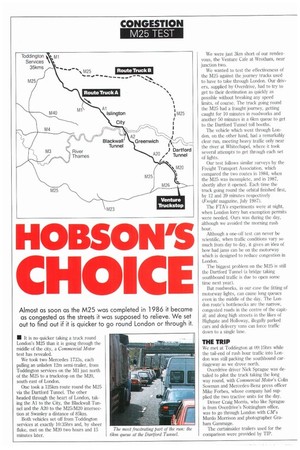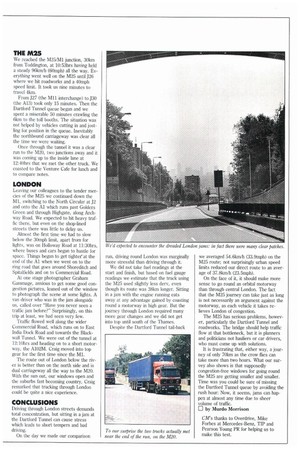HOBSON'S
Page 30

Page 31

If you've noticed an error in this article please click here to report it so we can fix it.
CHO CIE
Almost as soon as the M25 was completed in 1986 it became as congested as the streets it was supposed to relieve. We set out to find out if it is quicker to go round London or through it.
MI It is no quicker taking a truck round London's M25 than it is going through the middle of the city, a Commercial Motor test has revealed.
We took two Mercedes 1733s, each puffing an unladen 12m semi-trailer, from Toddington services on the M1 just north of the M25 to a truckstop on the M20, south east of London.
One took a 125km route round the M25 via the Dartford Twin& The other headed through the heart of London, taking the Al to the City, the Blackwall Tunnel and the A20 to the M25/M20 intersection at Swanley a di'stance of 85km.
Both vehicles set off from Toddington services at exactly 10:35hrs and, by sheer fluke, met on the M20 two hours and 15 minutes later. We were just 3km short of our rendezvous, the Venture Cafe at Wrotham, near junction two We wanted to test the effectiveness of the M25 against the journey trucks used to have to take through London. Our drivers, supplied by Overdrive, had to try to get to their destination as quickly as possible without breaking any speed limits, of course. The truck going round the M25 had a fraught journey, getting caught for 10 minutes in roadworks and another 50 minutes in a 6km queue to get to the Dartford 'runnel toll booths.
vehicle which went through London, on the other hand, had a remarkably clear run, meeting heavy traffic only near the river at Whitechapel, where it took several attempts to get through each set of lights.
Our test follows similar surveys by the Freight Transport Association, which compared the two routes in 1984, when the M25 was incomplete, and in 1987, shortly after it opened. Each time the truck going round the orbital finished first, by 12 and 39 minutes respectively (Freight magazine, July 1987).
The FTA's experiments were at night, when London lorry ban exemption permits were needed. Ours was during the day, although we avoided the morning rush hour.
Although a one-off test can never be scientific, when traffic conditions vary so much from day to day, it gives an idea of how bad jams can be on the motorway which is designed to reduce congestion in London.
The biggest problem on the M25 is still the Dartford Tunnel (a bridge taking southbound traffic is due to open some time next year).
But roadworks, in our case the fitting of motorway lights, can cause long queues even in the middle of the day. The London route's bottlenecks are the narrow, congested roads in the centre of the capital; and along high streets in the likes of Highgate and Holloway, illegally parked cars and delivery vans can force traffic down to a single lane.
THE TRIP
We met at Toddington at 09:15hrs while the tail-end of rush hour traffic into London was still packing the southbound carriageway as we drove north.
Overdrive driver Nick Sprague was detailed to pilot the truck taking the long way round, with Commercial Motor's Cohn Sowman and Mercedes-Benz press officer Mike Forbes, whose company had supplied the two tractive units for the day.
Driver Craig Morris, who like Sprague is from Overdrive's Nottingham office, was to go through London with CM's Murdo Morrison and photographer Graham Gammage.
The curtainsider trailers used for the comparison were provided by TIP.
THE M2S
We reached the M25/M1 junction, 30km from Toddington, at 10:53hrs having held a steady 96km/h (60mph) all the way. Everything went well on the M25 until J26 where we hit roadworks and a 40mph speed limit. It took us nine minutes to travel 4km.
From J27 (the M1 1 interchange) to J30 (the A13) took only 15 minutes. Then the Dartford Tunnel queue began and we spent a miserable 50 minutes crawling the 6km to the toll booths. The situation was not helped by vehicles cutting in and jostling for position in the queue. Inevitably the northbound carriageway was clear all the time we were waiting.
Once through the tunnel it was a clear run to the M20, two junctions away and it was coming up to the inside lane at 12:40hrs that we met the other truck. We coasted to the Venture Cafe for lunch and to compare notes.
LONDON
Leaving our colleagues to the tender mercies of the M25 we continued down the Ml, switching to the North Circular at J2 and onto the Al which runs past Golders Green and through Highgate, along Archway Road. We expected to hit heavy traffic there, but even on the shop-lined streets there was little to delay us.
Almost the first time we had to slow below the 30mph limit, apart from for lights, was on Holloway Road at 11:30hrs, where buses and cars began to hustle for space. Things began to get tighter' at the end of the Al when we went on to the ring road that goes around Shoreditch and Spitalfields and on to Commercial Road.
At one stage photographer Graham Gamrnage, anxious to get some good congestion pictures, leaned out of the window to photograph the scene at some lights. A van driver who was in the jam alongside us, called over "Have you never seen a traffic jam before?" Surprisingly, on this trip at least, we had seen very few.
Traffic flowed well along the wider Commercial Road, which runs on to East India Dock Road and towards the Blackwall Tunnel. We were out of the tunnel at 12:10hrs and heading on to a short motorway, the A102M. Craig moved into top gear for the first time since the Ml.
The route out of London below the river is better than on the north side and is dual carriageway all the way to the M20. With the sun out, our windows open and the suburbs fast becoming country, Craig remarked that trucking through London could he quite a nice experience.
CONCLUSIONS
Driving through London streets demands total concentration, but sitting in a jam at the Dartford Tunnel can cause stress which leads to short tempers and bad driving.
On the day we made our comparison run, driving round London was marginally more stressful than driving through it.
We did not take fuel readings at the start and finish, but based on fuel gauge readings we estimate that the truck using the M25 used slightly less derv, even though its route was 38km longer. Sitting in a jam with the engine running eats away at any advantage gained by coasting round a motorway in high gear. But the journey through London required many more gear changes and we did not get into top until south of the Thames.
Despite the Dartford Tunnel tail-back we averaged 54.6km/h (33.9mph) on the M25 route; not surprisingly urban speed limits reduced our direct route to an average of 37.8km/h (23.5mph).
On the face of it, it should make more sense to go round an orbital motorway than through central London. The fact that the M25 journey can take just as long is not necessarily an argument against the motorway, as each vehicle it takes relieves London of congestion.
The M25 has serious problems, however, particularly the Dartford Tunnel and roadworks. The bridge should help traffic flow at that bottleneck, but it is planners and politicians not hauliers or car drivers, who must come up with solutions.
It is frustrating that, either way, a journey of only 70km as the crow flies can take more than two hours. What our survey also shows is that supposedly congestion-free windows for going round the M25 are getting smaller and smaller. Time was you could be sure of missing the Dartford Tunnel queue by avoiding the rush hour: Now, it seems, jams can happen at almost any time due to sheer volume of traffic.
0 by Murdo Morrison
















































































































